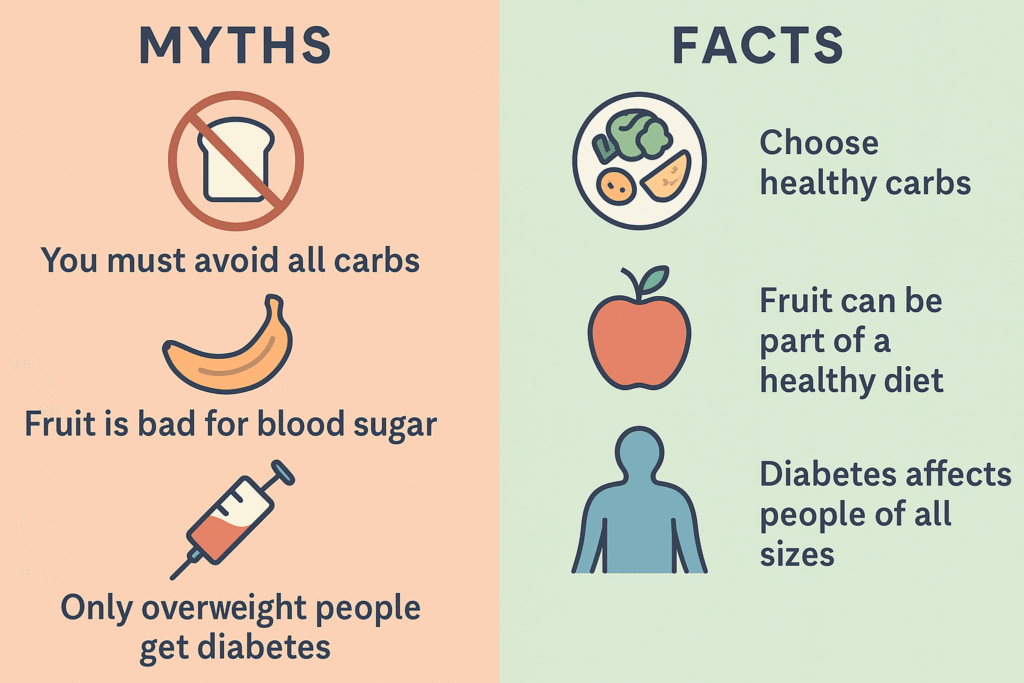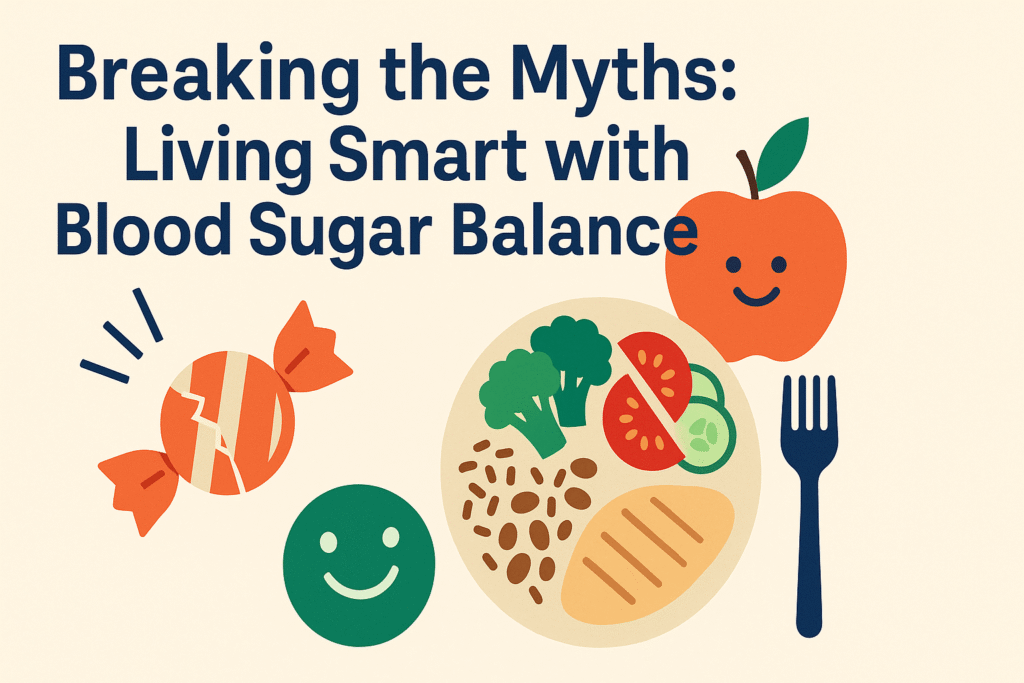Introduction: Why Myths Stick Around
If you ask five people about diabetes, you’ll probably get five different “rules.” One says “never eat carbs”. Another swears “fruit is poison”. A neighbor insists “if you’re thin, you’re safe.”
Spoiler: most of these are wrong. Diabetes is common, complex, and full of misconceptions. And while myths might make good headlines, they often leave people confused—or worse, scared. So today, let’s bust some myths with equal parts science and humor.

Myth #1: “Sugar Alone Causes Diabetes”
It’s tempting to blame sugar like the villain in a cartoon. But the reality? Type 2 diabetes develops from a mix of genetics, lifestyle, and long-term energy balance.
- Eating sugar doesn’t directly “cause” diabetes.
- However, a diet heavy in sugary drinks and ultra-processed foods can contribute to weight gain and insulin resistance.
👉 Sugar isn’t Voldemort—it’s not to be feared in small amounts, but it doesn’t deserve a free pass either.
Myth #2: “Carbs Are the Enemy”
Poor carbs, always the scapegoat. In reality, quality matters more than quantity.
- Whole grains, beans, and vegetables → fiber + slow digestion = steady blood sugar.
- Refined carbs (white bread, pastries, soda) → fast absorption = spikes and crashes.
👉 Carbs are like friends. Some will flake on you (donuts). Others will always have your back (oats, lentils, quinoa).
Myth #3: “Fruit Is Off-Limits”
One of the most frustrating myths!
- Fruit comes with fiber, water, and micronutrients that slow down sugar absorption.
- Research shows whole fruit is associated with a lower risk of type 2 diabetes, not higher.
- Fruit juice, on the other hand? Different story. No fiber = sugar rush.
👉 Bananas don’t bite back. Whole fruit is not your enemy—it’s your ally.
Myth #4: “If You’re Thin, You Can’t Get Diabetes”
Body size does influence risk, but it’s not the whole story.
- Genetics, ethnicity, age, and activity level also play big roles.
- Many people with a “normal” weight still develop type 2 diabetes.
- Conversely, some people in larger bodies never do.
👉 Metabolism doesn’t check your BMI before deciding.
Myth #5: “Exercise Has to Be Intense to Work”
You don’t need to become a marathoner to benefit.
- Brisk walking after meals can lower blood sugar.
- Resistance training builds muscle, improving insulin sensitivity.
- Even “movement snacks” (stretching, stair climbing, dancing in your kitchen) help.
👉 Think of exercise as “turning on the body’s sugar sponge.” It doesn’t need to be extreme—just consistent.
Fun Fact Intermission: The Coffee Effect ☕
Did you know moderate coffee drinkers tend to have a lower risk of type 2 diabetes? (According to large cohort studies). But careful: loading it with syrup and whipped cream turns your “ally” into a sugar bomb.
The Smarter Way to Live with Blood Sugar Balance
- Eat patterns, not rules. Aim for fiber + protein + healthy fats.
- Move daily. Even 10-minute walks after meals work wonders.
- Sleep well. Poor sleep = higher blood sugar the next day.
- Mind stress. Chronic stress raises cortisol, which interferes with insulin.
- Check myths at the door. If it sounds too strict or extreme, it probably is.
Key Takeaway
Diabetes myths spread faster than a viral TikTok—but knowledge is power. Sugar isn’t the sole villain, carbs aren’t always bad, and fruit isn’t forbidden. The truth is more balanced, more empowering, and frankly… way more interesting.
Living smart with blood sugar isn’t about fear—it’s about confidence, small daily habits, and enjoying life without falling for the myths.

David Thompson is a certified personal trainer and lifestyle coach with more than 12 years of experience. He helps busy adults create simple, effective workout routines that fit into everyday life. David believes that fitness should be approachable and motivating, not overwhelming.

